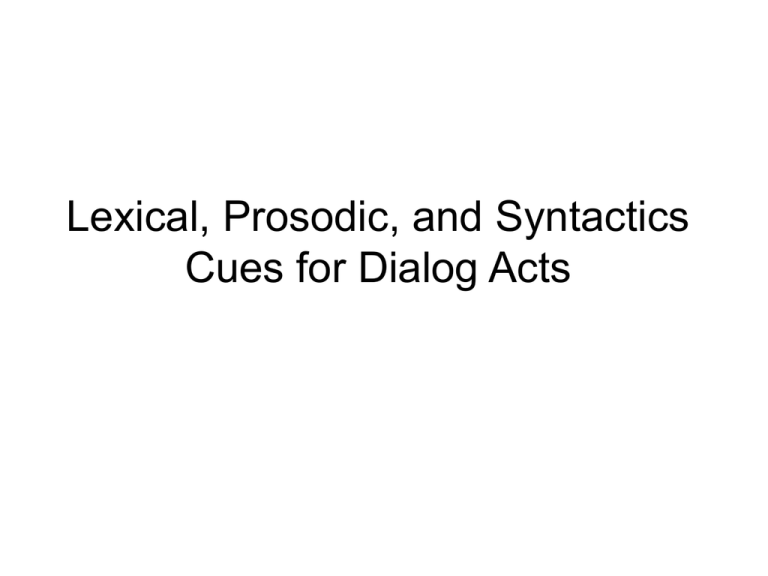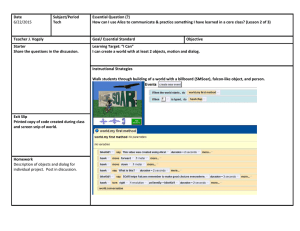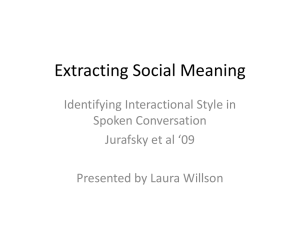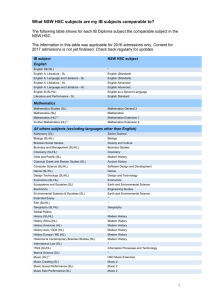Lexical, Prosodic, and Syntactics Cues for Dialog Acts
advertisement

Lexical, Prosodic, and Syntactics Cues for Dialog Acts Purpose • Investigating the particular class of dialogue acts called backchannels (aka "acknowledgement tokens"). Those give feedback to the speaker. • Continuers – an utterance indicating that the other speaker should go on speaking. • incipient speakership • agreements – marks the degree to which a user accepts the speakers opinion, statement, etc. • yes-answers • Assessments – ascriptive sentences: expression of a certain property ("good," "bad"). Questions • • • Does it have any importance as cuephrases for the structure? Does prosodic knowledge have any importance? Is there any difference in syntactic realization of certain dialog acts, compared to others? Who Cares? • • Part of a project to "automate discourse structure for speech recognition and understanding tasks" Create models of speakers and dialog. Materials and Methods • -SWBD-DAMSL dialog tagset: * an adaptation of DAMSL tag-set * ~60 labels that could be combined in different dimensions. • -7 CU-Boulder linguistics grad students labeling switchboard conversations of human-to-human interaction Results 220 unique tags for 205,000 utterances, where each utterance received exactly one tag. • Good agreement rate between labelers (84%), but too many tags for statistical analysis everything was condensed into 42 final tags On the lexical level, do words like "yeah" have any importance as cue-phrases for the structure?" • Hirschberg & Litman: "now" and "well." • Here: words with overlap meanings • Jurafsky’s Findings: utterances may be ambiguous, BUT through the lexical form, we could find the word's true "identity." "Yeah" Vs. "uh-huh": • “Yeah" (and variations): ambiguous ("agreements" at 36%, at "incipient speaker" at 59%", and 86% at "yesanswers") • "uh-huh" (with its variations): a "continuer" (45% vs. "yeah" at 27%). Next Question: "Does prosodic knowledge have any importance in determining DA's meaning?" • Hirschberg and Litman: intonational phrasing and pitch accent disambiguates cue phrases and help determine discourse structure. • Jurafsky: agrees. – Runs experiment: Text transcription vs. complete speech: MATERIALS AND METHODS: • 44 random, but previously labeled conversations. • Conversations were put in full context as well as fully transcribed AND the original labeling was also available. • RESULTS: 98% agreement! 2% • The shifts: 38% of the 2%: continuers agreements 19% of the 2%: opinions statements 15% of the 2% statements opinions Etc. Why the Shifts? – due to cascading changes (continuer agreement, preceding statement = opinion). – Nature of labeling instruction: ambiguous cases were labeled as continuers – Identical lexical form: some speakers distinguished agreement from continuer based on prosody, while others used lexical form. Take Home Message • Continuers are, in most cases (vs. agreements): – shorter in duration – less intonationally marked – long pauses before speaking 3rd Question:Is there any difference in syntactic realization of certain dialog acts, compared to others? • Goodwin and Goodwin: • Pro Term + Copula + (Intensifier) + Assessment Adjective • Formula happens frequently, where: – pro term mostly equals: "that" – intensifiers are rare, and are usually "really," and "pretty" – assessment adjective has small range of adjectives: great, good, nice, wonderful, etc. Syntactic Conclusion • "micro-syntax" – restricted grammatical production than would have thought. That is, certain dialog acts have their own syntactic patterning.



